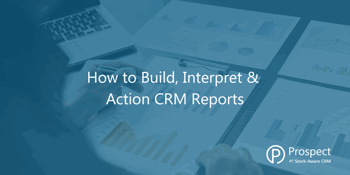
How to Build, Interpret & Action CRM Reports
The benefits of data-driven insights from CRM reporting tools are endless, but being able to access these benefits isn’t that simple. In this article, we reveal how to establish an effective CRM reporting system and how to leverage the insights it generates to achieve your long-term business objectives.
Whether you’re in Sales, Marketing, Customer Service - or anything in between - CRM reporting gives you a good grasp of the finer details of your performance, and paints a bigger picture of your wider business activities. According to a 2022 study by Gartner, 82% of buyers look for reporting capabilities in a CRM software; an effective reporting tool can be what separates a good CRM from a bad CRM.
Most CRM systems will have the ability to facilitate a range of different analytics, from sales forecasting to goal progress reports- but knowing how to use these insights to your advantage isn’t always straightforward. With a set of quantifiable goals mapped out, and a well-founded strategy in place, CRM reporting tools can be what elevates you from start-up to success.
What is CRM Reporting
A CRM system not only serves as a simple customer management tool that fosters better relationships and drives sales, it’s also an extremely powerful analytical tool that collects, processes, and generates insights on vast amounts of customer and sales data. While it may seem that CRM reports only produce generic insights such as sales performance or pipeline progress, their purpose goes far beyond. Helping you to sell smarter, act faster, and grow stronger, here’s just a few reporting insights a good CRM can give you:
- Customer analytics (purchasing behaviours, upsell opportunities, churn rate)
- Campaign analytics (conversion rates, ROI, lead source tracking
- Sales analytics (pipeline, close rates, forecasts)
Build
Configuring your reports is only the first step in establishing a reporting system that improves your efficiency as a business, but getting the basics right lays down a critical foundation to get you started.
Outline your objectives
Monitoring a large number of reports daily or weekly can be a demanding task, so having clear goals in mind can help to narrow down and optimise your workload.
Are you trying to increase campaign engagement or is your main focus maximising customer loyalty? By answering these questions, you can pinpoint which performance metrics will help you reach your goals, and build out analytics with CRM reporting that produce the insights you need.
Configure the essentials
For wholesalers, distributors and manufacturers, choosing a CRM that offers a set of standard reports to drive sales growth is essential:
- New customers report: This CRM report tells you which customers are new, so you include them in a welcome series and onboard them successfully. Getting these transactional customers to place more orders will turn them into loyal, frequent purchasers.
- Churn rate report: A churn CRM report outlines how many of your customers have moved away from your business. This gives you an idea of which customers might have left to your competition, so you can identify reasons for customer attrition to determine how to improve satisfaction.
- Customers that bought product X but not product Y: Knowing which customers purchased one specific product from you but not another using your CRM reporting can help you identify which customers to target in your next upsell email campaign for promoting similar or complimentary products. Increasing awareness of a second item can encourage greater purchase volume per customer and increase average order values.
Interpret
Using the objectives you set during the building stage, you can decipher your analytics, decide whether they align with your goals, and devise a plan of action.
Listen to predictions
Some CRMs use AI-driven features that utilise report patterns to notify you of a predictable circumstance, such as predicted churn alerts. AI-driven insights take the administrative element out of your CRM reporting process, so you can start acting on predictions while there’s still time, and prioritise tasks that drive sales.
Sieve out inaccurate data
To achieve optimal results, your CRM reports need to be as clear-cut as possible so you know exactly what action needs to be taken. Any anomalies in your dataset can skew your results, and human error can play a big part in this. Ensuring your CRM’s data integrity is always first-rate guarantees that your analytics will send you in the right direction.
Action
Now that you understand what your insights mean, you can start to use them to maximise sales and drive profitable business growth with the power of data.
Revise your workflow
CRM reports are designed to help you identify your pain points so you can adapt your workflow to be more efficient and productive. Whether you’re struggling to maximise customer lifetime value (CLTV) or your email campaigns aren’t performing well, your CRM reports should give you a good visual view of where you’re falling short so you can focus in on this area.
Create a CRM strategy
The features within your CRM should work in tandem with one another so that you can devise a CRM strategy that leverages your reporting results. An effective B2B CRM strategy should be driven by goals and data, and should be the first stage of actioning your insights. A powerful CRM strategy keeps your whole team on track, ensuring that you’re optimising performance and promoting maximal profitable growth at all times.
Improve Your Reporting Strategy with Prospect CRM
For most CRMs, reporting is available as a standard feature with pre-made templates for easy configuration and quick insights – these, however, are typically very broad. So, while they’re convenient for small businesses adopting a new CRM system and grasping the basics of new functionalities, or businesses generally wanting to identify areas where there may be quick wins, their lack of depth makes them insufficient for the reporting needs of scaling businesses.
As the #1 Stock-Aware CRM with integrative capabilities to back-office accounting, inventory, and ERP systems, Prospect CRM gives growing wholesalers, manufacturers, and distributors the best-of-both worlds. Sets of pre-made CRM reports build the foundations for data management and business analysis while configurable B2B end-to-end reporting features tap into siloed data to give unique insights into all business aspects – from customer data, sales performance, inventory levels, and even financial transactions.
The benefits of Prospect CRM reports don’t just stop there. Once fully integrated to your back-office systems, seamless data synchronisation will save the time spent on previous administrative tasks like manually cross-referencing and updating data between systems – this means you can also be certain that you’re always viewing real-time data. Removing this need to manually update data also prevents the inevitable human-prone errors which cost you both time and money!
Explore End-to-End Reporting with a 14-day free trial of Prospect CRM.
